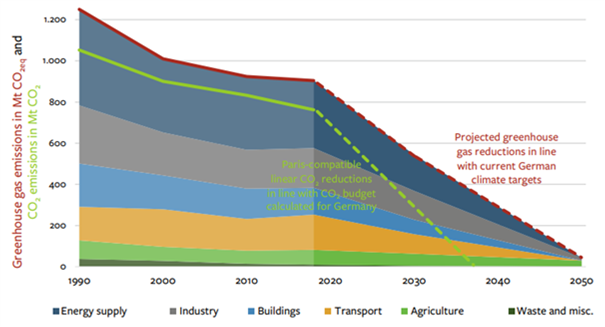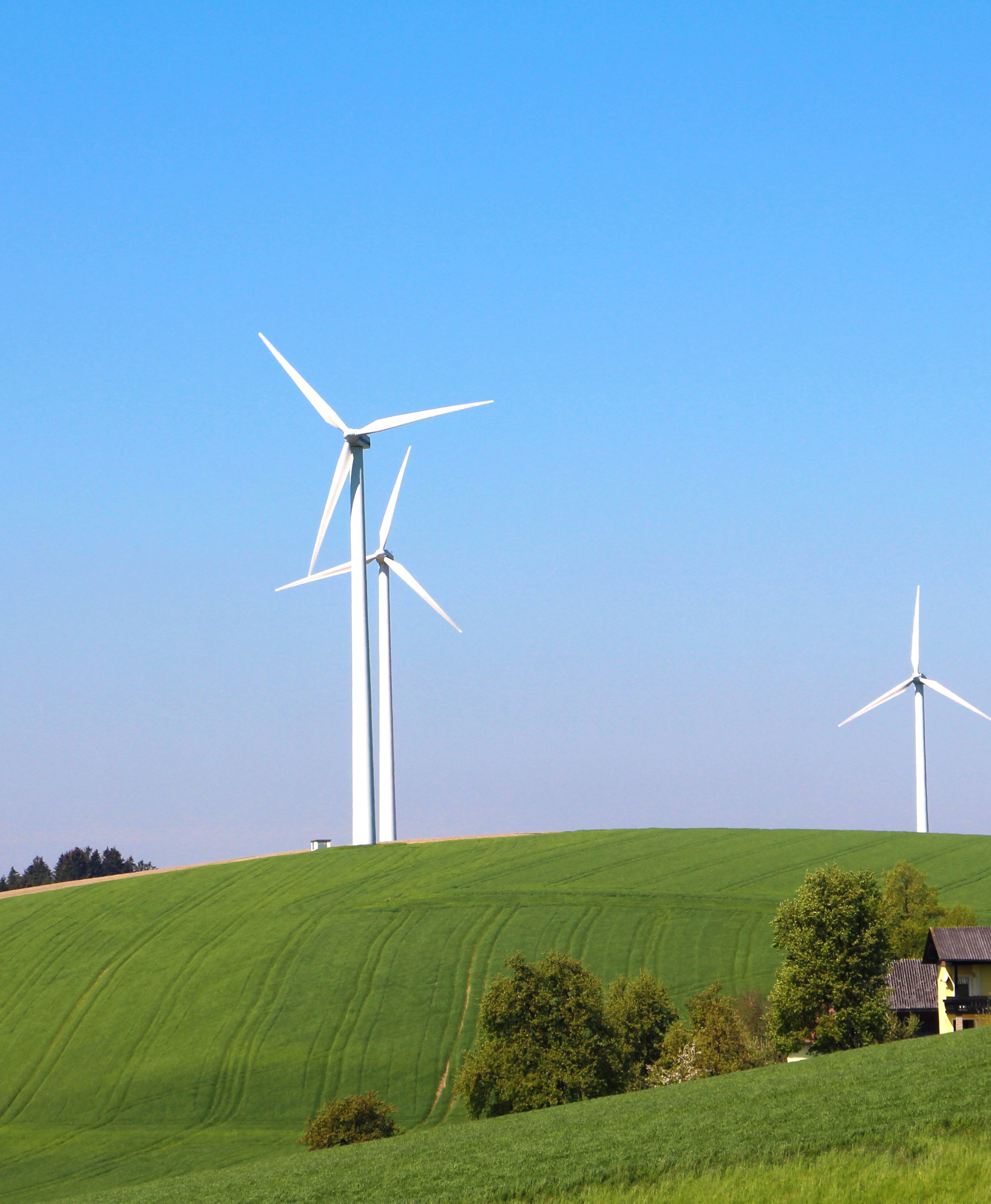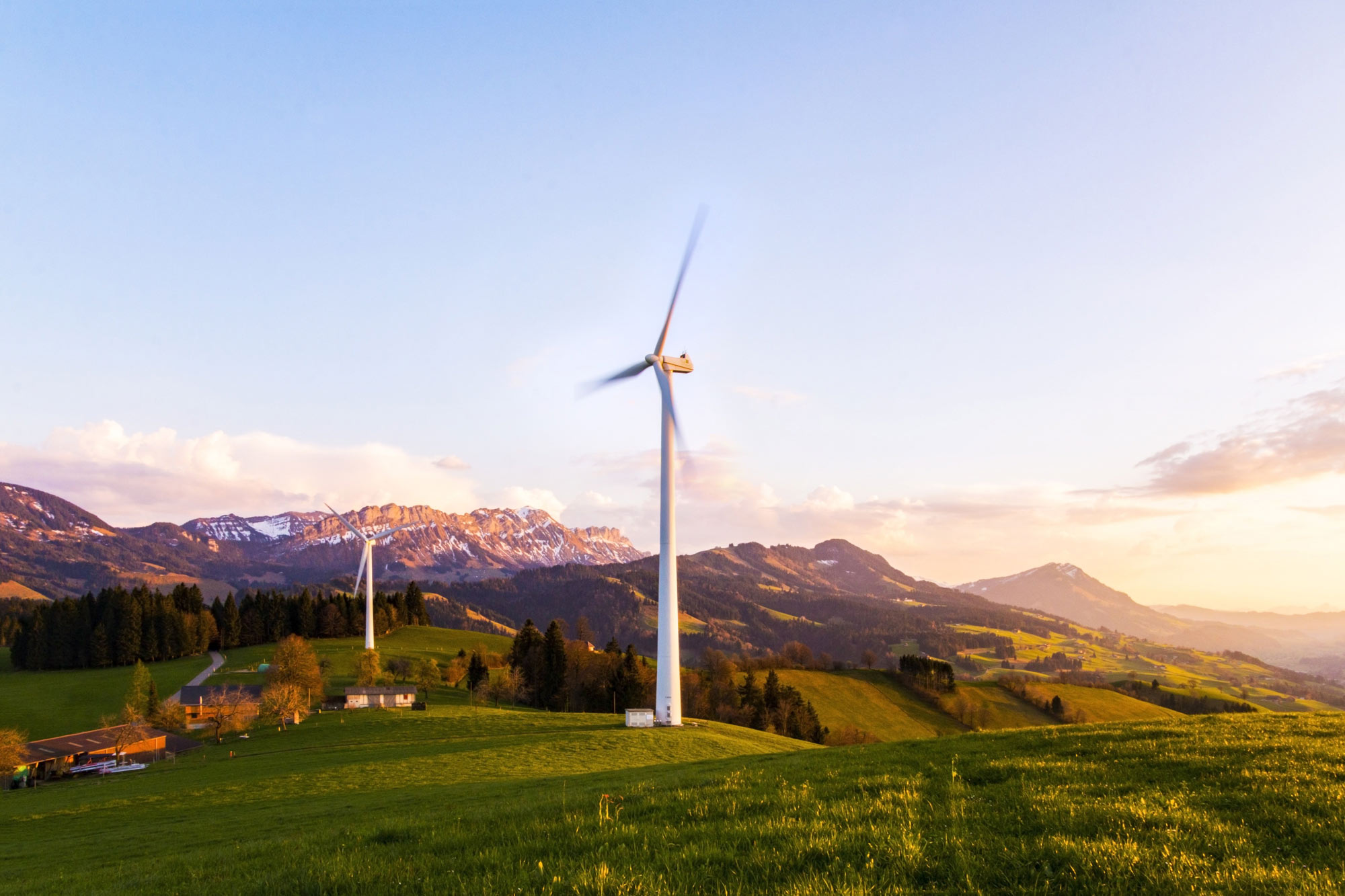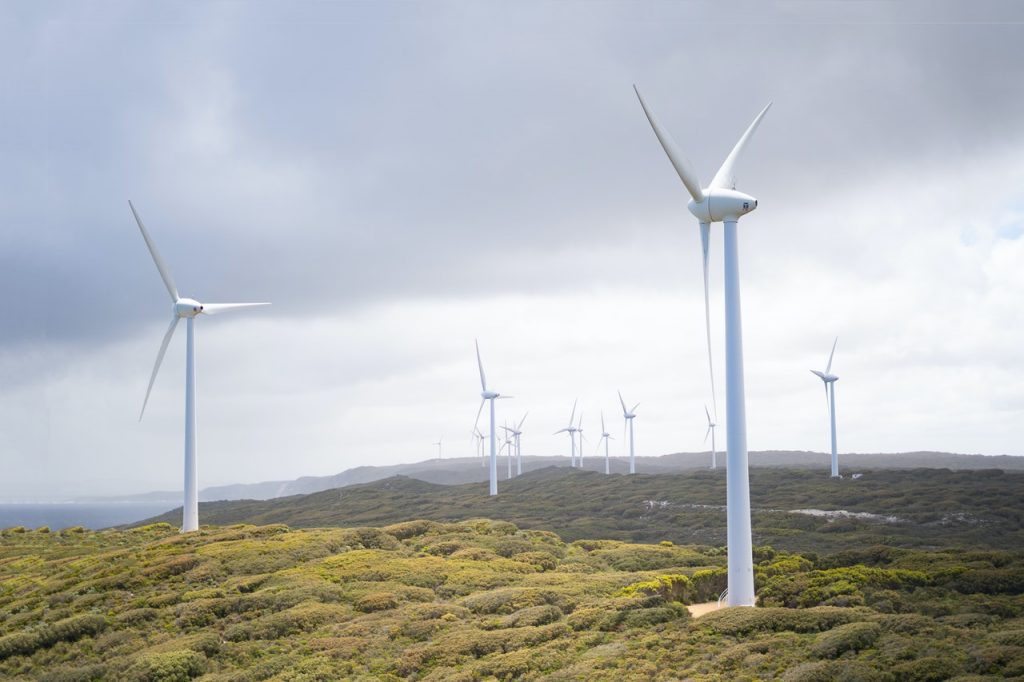Floods of the century in western Germany, monthly reports of record temperatures since weather records began, southern Europe in flames, heat deaths in Canada and the U. S. – it’s not just the Fridays for Future movement manifesting the issue of climate protection couldn’t be more pressing. But will the upcoming federal election actually be a climate election? Will the decision of German voters set the tone for climate protection? How big are the differences between the parties’ demands? And above all – what does this mean for the expansion of renewable energy in Germany? We have compared the programmes of the major parties with regard to their statements on wind energy and photovoltaics.
According to the decision of the Federal Constitutional Court, the previous efforts laid down in the Climate Protection Act are not sufficient to meet the European targets for climate protection (1). Therefore, the previous contents are not sufficient to achieve the binding maximum annual emission levels by the year 2030. This is based on the calculations of the German Advisory Council on the Environment (Sachverständigenrat für Umweltfragen – SRU) on a German CO2 residual budget until climate neutrality is achieved in 2050 (2). The previous climate protection determined emission levels until 2030, however this almost equals the complete remaining CO2 budget (3). The resulting obligation of future generations to be climate neutral from 2030 onwards has been declared unconstitutional (1).
In the previous Climate Protection Act the federal government set targets to reduce CO2 emissions to 543 megatons by 2030 and envisaged a 95 % reduction by 2050. The recently passed amendment to the Act brought forward the target of greenhouse gas neutrality until 2045 and introduced the system of annualised permissible emission levels (4). According to SRU’s calculations, the predefined national CO2 budget would already be exhausted in 2038 if linear CO2 reductions were applied starting in 2019.
The goals and measures that the individual parties represented in the Bundestag have set in their election programmes to achieve climate neutrality are examined in more detail below. The order of the parties is based on the results of the last federal election in 2017.

Figure 1: Path of emission reduction in the individual sectors in Germany (2)
CDU/CSU
The conservative Christian Democrats CDU/CSU presented their joint election programme at the end of June (5). “Germany should become faster, more efficient and more digital – and be climate-neutral at the same time.” At the presentation of the programme, chancellor candidate Laschet emphasised that the CDU/CSU would combine consistent climate protection with economic strength and social security.
Table 1: Set periods to achieve climate and energy goals by the CDU/CSU (5)
Overview Targets | Climate neutrality by | Fossil-fuel exit by | 100 % Renewables by | Wind and PV expansion targets |
2045 | 2038 as agreed | No specification | ||
The CDU/CSU states that making a few adjustments is insufficient, the party is therefore focusing on modernisation and social market economy in the coming decade. With regard to the fight against climate change, there is no lack of ambitious goals, yet there is an absence of actual ideas and proposals for rapid implementation. Surprisingly – and not without causing displeasure among the CDU – the CSU published its own action paper at the end of July (6 & 7).
For the increasingly extensive planning and approval procedures for wind energy projects, the CDU/CSU plans to shorten planning and approval procedures through digitisation, uniform standards and better networking between authorities. However, these approaches aren’t new. Economics Minister Peter Altmaier already mentioned such approaches two years ago in his work plan for strengthening onshore wind energy (8). After all, from 4initia’s broad practical experience, it must be stated that it had no positive impact on ongoing procedures so far. In many cases, it has even been observed that the requirements of the authorities have increased. A significant shortening would accelerate the expansion of wind energy. At least Markus Söder held out the prospect of easing the highly controversial minimum distance rule for wind turbines in a government statement to the Bavarian Parliament at the end of July (6).
In contrast, the “Energy Concept for the Future” reads like a “business as usual” with regard to the expansion of wind energy and photovoltaic plants, albeit as a commitment to both technologies. The concept did not specify any higher expansion targets. Although the programme focuses on future technologies such as storage and hydrogen, Germany’s growing energy needs in conjunction with the phase-out of nuclear and coal-fired power will require ambitious expansion plans for the key technologies of wind energy and photovoltaics (9).
The Union’s election programme lists some proposals for reducing CO2 emissions independently of electricity production. Agriculture which is as a major contributor to greenhouse gas emissions is also taken into account. Another focus is on further establishing emissions trading both nationally and internationally.
SPD
In its election programme, the socialdemocratic SPD identifies four future missions to promote German climate and energy policy (10). One of the missions is dedicated to the protection against climate change and the transformation toward a climate-neutral Germany. To this end, several targets have been set in order to meet the 1.5 °C goal of the Paris Agreement, especially attained by the help of the expansion of renewable energy sources such as wind power, solar power and hydrogen. The SPD aims for a 65 % share of renewables in the electricity market by 2030 and 88 % by 2040, with climate neutrality achieved by 2045.
Table 2: Set periods to achieve climate and energy goals by the SPD (10)
Overview Targets | Climate neutrality by | Fossil-fuel exit by | 100 % Renewables by | Wind and PV expansion targets |
2045 | 2038 as agreed | 2040 | No specification | |
One action to be implemented at the beginning of the coming legislative period is the generation of solar power on public buildings and new commercial buildings. In addition, building heat should be regulated by renewable energy and the existing EEG levy is to be replaced by financing from the federal budget by 2025. The funding is made up of CO2 pricing, among other things.
To exit energy production by fossil fuels as quickly as possible, the party’s main focus is on the expansion of renewable energy. In addition to renewable power generation, necessary measures such as the expansion of power grids, rail lines, hydrogen pipelines and charging stations for electric cars are to be implemented. Since many sectors of the economy are to switch to renewable energy, such as transportation and industry, the demand for electricity will increase rapidly, making rapid expansion essential. In areas where electrification is not feasible, hydrogen from renewable energy is to be used. On a bigger picture, the SPD set the goal of Germany becoming a role model for hydrogen technologies by 2030, enabling various aspects of mobility and industrial production to be made climate-neutral.
While concrete expansion targets in renewable energy sources are stated in the SPD’s election programme, the programme lacks clear statements on achieving climate neutrality and fossil phase-out.
FDP
With the statement “More German courage for more climate protection and sustainable development” the liberal FDP presents its demands in the field of energy and climate policy in its election programme (11).
Table 3: Set periods to achieve climate and energy goals by the FDP (11)
Overview Targets | Climate neutrality by | Fossil-fuel exit by | 100 % Renewables by | Wind and PV expansion targets |
2050 | after 2038 | No specification | ||
The FDP considers the cost of electricity in Germany too excessive for almost all consumer groups. To achieve a reduction in costs, the gradual abolition of the EEG levy is planned alongside a reduced electricity tax to the EU minimum. Existing support commitments are to be financed by pricing of CO2. As a result, renewable energy will be completely transferred to competition without state-guaranteed purchase prices. The party expressly rejects expansion paths for individual technology carriers. The CO2 price is to be extended geographically and to all sectors. Permissible emissions, for which certificates must be purchased, are set annually. Their annual scarcity will lead to a price increase, which should make climate-friendly technologies more attractive. However, no concrete details are given on the design and implementation of the CO2 price. Within the framework of the climate dividend, an annually calculated lump sum that is paid out to the population, the revenue neutrality of the CO2 pricing is to be guaranteed.
The FDP plans to expand hydrogen and synthetic fuels alongside electricity as a second pillar in the future energy system and to promote the hydrogen economy. Volatile renewable electricity can be stored and transported by producing hydrogen using electrolysis. To ensure energy production at low cost, global plant investments are required. Wind power or photovoltaic plants at suitable locations in conjunction with connected infrastructure would be suitable for the production of energy sources. The election programme lacks specifics as to when, where and how the required amounts of electricity are to be generated.
To simplify lengthy approval procedures for the expansion of renewable energy, bureaucracy in energy law, planning and approval procedures are to be reduced. Since the energy transition must be cross-sectoral, the FDP does not rely on complete direct electrification from renewable power in the future energy system. The FDP strives for a science-based energy policy that is based on innovation, competition, and high level of acceptance in society.
In its election programme, the FDP acknowledges the goal of climate neutrality until 2050. However, no statement is made whether the party intends to cover 100 % of Germany’s future electricity demand with renewable energy.
The climate policy demands focus on technological and market-based solutions. With the help of innovations and the use of new technologies, energy should be transformed cost-effectively and contribute to climate protection. The negative consequences of climate change on the environment are to be overcome through innovative solutions and competition. For this reason, the party is in favor of tax incentives for research and development of precisely those technologies that contribute to climate protection.

Die Linke
Under the title “Time to act! For Social Security, Peace and Climate Justice”, the Left Party Die Linke was one of the last parties to publish its election programme on 20th June (12). While national CO2 pricing is being lively discussed in some parties, the Left Party is specifically against trading emissions certificates. Instead, binding climate targets and emission caps should be implemented for corporations but also for civil society. At the EU level, on the other hand, the party calls for a reform of EU emissions trading, with no inclusion of the transport and heating sectors in the EU ETS.
Table 4: Set periods to achieve climate and energy goals by the Left Party (12)
Overview Targets | Climate neutrality by | Fossil-fuel exit by | 100 % Renewables by | Wind and PV expansion targets |
2040 | 2030 | 2035 | Until 2025: | |
The Left Party criticises the current government’s missed opportunity to take sufficient measures to limit global warming to a maximum of 1.5 °C. To minimise the extent of global warming, the party is striving for climate neutrality and thus a complete halt to the use of fossil fuels by 2035. In order to avoid rebound effects, the aim is not only to rely on sustainable technologies, but also to initiate a socio-ecological system change. This includes, on the one hand, the disempowerment of large energy companies and the orientation of production in public or cooperative ownership. By 2030, the party wants to achieve a reduction of national emissions by at least 80 % compared to the 1990 reference level.
In concrete terms, the Left Party is promoting a structural transformation of the EEG. In order to reduce the cost of implementing citizen energy projects, tendering systems should only apply to projects with a total output of 18 MW or more, or with a project size of five plants or more. The party’s goal is to expand total capacity to 10 GW per year in photovoltaics, 7 GW in onshore wind power and 2 GW in offshore wind power by 2025. The mandatory involvement of the local communities is intended to facilitate participation in wind energy, PV and energy storage projects. Among other things, the energy turnaround is to be designed close to the population with the help of tenant electricity concepts, energy cooperatives and bioenergy villages, while energy poverty is to be prevented by affordable base rates.
Overall, the party presents ambitious goals in its election programme, but it does not go into further detail how the political aspirations are planned to be implemented. This raises the question of whether the “socio-ecological system change” promised by the Left Party is backed up by the necessary instruments.
Bündnis 90/Die Grünen
Annalena Baerbock summarises the central aspects of the Greens election programme with the question “How can we reconcile the economy and climate protection while at the same time ensuring more social justice?” (13 & 14). While the election programme which was adopted in June substantiates the party’s long-term goals, the Greens presented the basis for an immediate climate protection programme at the beginning of August increasing the pressure for action on climate protection among the other parties (15).
Table 5: Set periods to achieve climate and energy goals by the Greens (14)
Overview Targets | Climate neutrality by | Fossil-fuel exit by | 100 % Renewables by | Wind and PV expansion targets |
2040 | 2030 | 2035 | Wind onshore: 5-6 GW/year | |
The party aims for an accelerated coal phase out by 2030, compared to the agreed timeframe by the governing grand coalition until 2038. The negative environmental impacts of fossil fuel production are planned to be priced by emissions trading at national and EU level. In case no impact can be observed by the EU ETS (EU Emissions Trading System), the party proposes a national minimum CO2 price of € 60 per ton of CO2 in the sectors energy industry and energy-intensive industry. The price would thus be slightly higher than the set CO2 price by the German government.
At the same time, the expansion of renewable energy is to be driven forward – specifically, Germany’s energy supply is planned to be generated by 100 % renewables by 2035. For this reason, the Greens have set the goal of equipping a further 1.5 million roofs with PV systems within the next four years, supported by leasing, rental and contracting models. The realisation of roof systems along with the construction of photovoltaic projects on open spaces is to be facilitated by political and legal adjustments.
The party wants to use around two percent of land nationwide for the expansion of renewable energy including a reduction in bureaucracy during the approval of wind energy projects. Baerbock speaks of an “offer for the whole range of society” (16). The energy turnaround is to be shaped as close to the population as possible with the help of energy communities and the participation of communities in the revenues of renewable energy projects.
The immediate climate protection programme for the next federal government, published by the Greens, takes up the central core points of the party programme. It lists ten precise proposals on how climate protection policy is to be implemented directly in the next legislative period. These measures are to be implemented with the help of a climate protection task force under the leadership of a climate protection ministry.

Conclusion
While in the programmes of past federal elections little attention was paid to the topics environmental and climate, all the parties mentioned the topic climate policy in their current election programmes. However, most of the parties are lacking concrete plans for implementation.
The parties react hesitantly and with little specificity, while calls for more stringent measures from civil society for climate protection are getting louder. While the FDP is aiming for national climate neutrality by 2050 and lacks the necessary intermediate steps, the CDU/CSU and SPD want to achieve a greenhouse gas-neutral Germany by 2045. Only the Greens and the Left Party have set 2035 as their target.
Although all parties are committed to the goals of the Paris Agreement, it is still vague whether the efforts of the individual parties will be sufficient to limit global warming below 2 °C. The decisive factor now is the composition of the upcoming governing coalition, as well as the will of those parties to implement climate action.
Note: The election programme of the right-winged populist party AfD was deliberately not discussed. One of many reasons is that the party denies human-made climate change.
By: Laura Geiselmann, Annika Görnt, Anna Probst, Thomas Rumpel and Mirko Siegmund
References:
(1) Bundesverfassungsgericht (2021). Verfassungsbeschwerden gegen das Klimaschutzgesetz teilweise erfolgreich: Bundesverfassungsgericht – Presse – Verfassungsbeschwerden gegen das Klimaschutzgesetz teilweise erfolgreich (retrieved on 24.08.2021).
(2) Sachverständigenrat für Umweltfragen (SRU) (2020). Pariser Klimaziele erreichen mit dem CO2-Budget. Available at: https://www.umweltrat.de/SharedDocs/Downloads/DE/01_Umweltgutachten/2016_2020/2020_Umweltgutachten_Kap_02_Pariser_Klimaziele.pdf?__blob=publicationFile&v=29 (retrieved on 06.08.2021).
(3) Deutscher Bundestag (2019). Entwurf eines Gesetzes zur Einführung eines Bundes-Klimaschutzgesetzes. Available at: https://dserver.bundestag.de/btd/19/143/1914337.pdf (retrieved on 06.08.2021).
(4) Deutscher Bundestag (2021) Entwurf eines Ersten Gesetzes zur Änderung des Bundes-Klimaschutzgesetzes. Available at: https://www.bmu.de/fileadmin/Daten_BMU/Download_PDF/Glaeserne_Gesetze/19._Lp/ksg_aendg/Entwurf/ksg_aendg_bf.pdf (retrieved on 06.08.2021).
(5) CDU/CSU (2021). Das Programm für Stabilität und Erneuerung. Gemeinsam für ein modernes Deutschland. Available at: https://www.csu.de/common/download/Regierungsprogramm.pdf (retrieved on 06.08.2021).
(6) Bayerischer Landtag (2021). Bayerns Klimaziele im Blick. Available at: https://www.bayern.landtag.de/aktuelles/aus-dem-plenum/21072021-regierungserklaerung/ (retrieved on: 06.08.2021).
(7) Redaktionsnetzwerk Deutschland (RND) (2021). Klimaschutz ins Grundgesetz? Unmut in CDU und CSU über Söder-Vorstoß. Available at: https://www.rnd.de/politik/klimaschutz-ins-grundgesetz-unmut-in-cdu-und-csu-uber-soder-vorstoss-W6KRJ5HGRMGGU37YJXFTEJ4LSQ.html (retrieved on 24.08.2021)
(8) Bundesministerium für Wirtschaft und Energie (BMWi) (2021). Bundeswirtschaftsministerium legt Arbeitsplan zur Stärkung der Windenergie an Land vor. Available at: https://www.bmwi.de/Redaktion/DE/Pressemitteilungen/2019/20191007-bmwi-legt-arbeitsplan-zur-staerkung-der-windenergie-an-land-vor.html (retrieved on 06.08.2021).
(9) AG Energiebilanzen e.V. (AGEB) (2021). Energieverbrauch in Deutschland – Daten für das 1. Quartal 2021. Available at: https://ag-energiebilanzen.de/20-0-Berichte.html (retrieved on 06.08.2021).
(10) Sozialdemokratische Partei Deutschland (SPD) (2021). Aus Respekt vor deiner Zukunft. Das Zukunftsprogramm der SPD. Available at: https://www.spd.de/fileadmin/Dokumente/Beschluesse/Programm/SPD-Zukunftsprogramm.pdf (retrieved on 06.08.2021).
(11) Freie Demokratische Partei (FDP) (2021). Wahlprogramm der Freien Demokraten. Available at: https://www.fdp.de/sites/default/files/2021-06/FDP_Programm_Bundestagswahl2021_1.pdf (retrieved on 06.08.2021).
(12) DIE LINKE (2021). Zeit zu handeln! Für soziale Sicherheit, Frieden und Klimagerechtigkeit. Wahlprogramm zur Bundestagswahl 2021. Available at: https://www.die-linke.de/fileadmin/download/wahlen2021/Wahlprogramm/DIE_LINKE_Wahlprogramm_zur_Bundestagswahl_2021.pdf (retrieved on 06.08.2021).
(13) ZDFheute (2021). Baerbock nach Parteitag “Märkte der Zukunft sind klimaneutral”. Available at: https://www.zdf.de/nachrichten/politik/baerbock-gruene-bundestagswahl-programm-100.html (retrieved on 06.08.2021).
(14) BÜNDNIS 90/DIE GRÜNEN (2021). Deutschland. Alles ist drin. Bundestagswahlprogramm 2021. Available at: https://cms.gruene.de/uploads/documents/Wahlprogramm-DIE-GRUENEN-Bundestagswahl-2021_barrierefrei.pdf (retrieved on: 06.08.2021).
(15) BÜNDNIS 90/DIE GRÜNEN (2021). Klima retten, Menschen schützen. Klimaschutz-Sofortprogramm für die nächste Bundesregierung. Available at: https://cms.gruene.de/uploads/documents/20210803_Klimaschutz-Sofortprogramm.pdf (retrieved on 06.08.2021).
(16) Deutschlandfunk (2021). Bundestagswahl 2021. Available at: https://www.deutschlandfunk.de/bundestagswahl-2021-was-im-wahlprogramm-der-gruenen-steht.2897.de.html?dram:article_id=494383 (retrieved on 06.08.2021).


